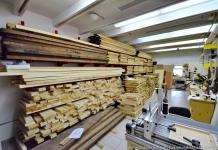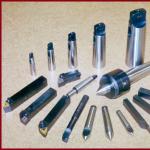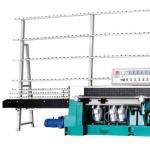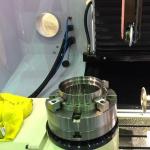Below I will give a table of wire cross-sections, but I recommend that you be patient by reading this small theoretical part to the end.
This will allow you to be more conscious in choosing wires for wiring, in addition, you can independently make wire section calculation, moreover, even "in the mind."
The passage of current through the conductor is always accompanied by the release of heat (respectively, heating), which is directly proportional to the power dissipated in the wiring section. Its value is determined by the formula P=I 2 *R, where:
- I - the value of the flowing current,
- R is the resistance of the wire.
Excessive heat may cause insulation failure, resulting in a short circuit and/or fire.
The current flowing through the conductor depends on the load power (P), defined by the formula
I=P/U
(U is the voltage, which for a household electrical network is 220V).
The wire resistance R depends on its length, material and section. For electrical wiring in an apartment, cottage or garage, the length can be neglected, but the material and cross section must be taken into account when choosing wires for electrical wiring.
CALCULATION OF THE SECTION OF THE WIRE
The cross section of the wire S is determined by its diameter d as follows (hereinafter, I will simplify the formulas as much as possible):
S=π*d 2 /4=3.14*d 2 /4=0.8*d 2.
This may come in handy if you already have a wire, and without a marking that immediately indicates the cross section, for example, VVG 2x1.5, here 1.5 is the cross section in mm 2, and 2 is the number of cores.
The larger the cross section, the greater the current load the wire can withstand. With the same sections of copper and aluminum wires - copper can withstand more current, in addition, they are less brittle, oxidize worse, therefore they are most preferable.
Obviously, with a hidden installation, as well as wires laid in a corrugated hose, an electrical box, due to poor heat transfer, they will heat up more strongly, which means that their cross section should be chosen with a certain margin, so it's time to consider such a value as current density (let's denote it Iρ).
It is characterized by the amount of current in amperes flowing through the unit section of the conductor, which we will take as 1mm 2. Since this value is relative, it is convenient to use it to calculate the cross section using the following formulas:
- d=√ 1.27*I/Iρ =1.1*√I/Iρ- get the value of the wire diameter,
- S \u003d 0.8 * d 2 - previously obtained formula for calculating the section,
We substitute the first formula into the second, round everything that is possible, we get a very simple ratio:
S=I/Iρ
It remains to determine the value of the current density Iρ), since the operating current I) is determined by the power of the load, I gave the formula above.
The permissible value of the current density is determined by many factors, the consideration of which I will omit and give the final results, and with a margin:
Calculation example:
We have: the total load power in the line is 2.2 kW, the wiring is open, the wire is copper. For the calculation we use the following units of measurement: current - Ampere, power - Watt (1kW = 1000W), voltage - Volt.
S=I/Iρ=(2200/220)/10=1mm 2
If you carry out the appropriate calculations for the entire range of wire cross-sections, you can get the corresponding table.
WIRE SECTION TABLE
I warn you right away, data from different sources may vary. This difference is determined by the power margin. Making calculations, I took this reserve to the maximum, bearing in mind that it is better to buy more powerful, respectively more expensive wires than to redo the burned-out electrical wiring later.
I bring to your attention the table promised at the beginning of the article:

© 2012-2020 All rights reserved.
The materials presented on the site are for informational purposes only and cannot be used as guidelines and normative documents.
When laying electrical wiring, you need to know what kind of cable with conductors you will need to lay. The choice of cable section can be done either by power consumption or by current consumption. You also need to take into account the length of the cable and the method of installation.
We select the cable cross-section by power
You can select the cross section of the wire according to the power of the devices that will be connected. These devices are called load and the method can also be called "by load". Its essence does not change from this.
We collect data
To begin with, find the power consumption in the passport data of household appliances, write it out on a piece of paper. If it's easier, you can look at the nameplates - metal plates or stickers fixed on the body of equipment and equipment. There is basic information and, most often, there is power. The easiest way to identify it is by units of measurement. If the product is manufactured in Russia, Belarus, Ukraine, the designation is usually W or kW, on equipment from Europe, Asia or America, the English designation of watts is usually W, and the power consumption (it is needed) is indicated by the abbreviation "TOT" or TOT MAX.

If this source is not available either (the information has been lost, for example, or you are just planning to purchase equipment, but have not yet decided on the model), you can take the average statistical data. For convenience, they are summarized in a table.

Find the equipment that you plan to install, write out the power. It is sometimes given with a wide spread, so it is sometimes difficult to understand which figure to take. In this case, it is better to take the maximum. As a result, when calculating, you will have a slightly overestimated power of the equipment and you will need a cable with a larger cross section. But for calculating the cable section, this is good. Only cables with a smaller cross-section than necessary are lit. Routes with a large cross section work for a long time, as they heat up less.
The essence of the method
To select the wire cross-section according to the load, add up the power of the devices that will be connected to this conductor. At the same time, it is important that all powers are expressed in the same units of measurement - either in watts (W) or in kilowatts (kW). If there are different values, we bring them to a single result. To convert, kilowatts are multiplied by 1000 to get watts. For example, let's convert 1.5 kW to watts. This will be 1.5 kW * 1000 = 1500 watts.
If necessary, you can carry out the reverse conversion - convert watts to kilowatts. For this, we divide the figure in watts by 1000, we get kW. For example, 500 W / 1000 = 0.5 kW.
| Cable section, mm2 | Conductor diameter, mm | Copper wire | aluminum wire | ||||
| Current, A | power, kWt | Current, A | power, kWt | ||||
| 220 V | 380 V | 220 V | 380 V | ||||
| 0.5 mm2 | 0.80 mm | 6 A | 1.3 kW | 2.3 kW | |||
| 0.75 mm2 | 0.98 mm | 10 A | 2.2 kW | 3.8 kW | |||
| 1.0 mm2 | 1.13 mm | 14 A | 3.1 kW | 5.3 kW | |||
| 1.5 mm2 | 1.38 mm | 15 A | 3.3 kW | 5.7 kW | 10 A | 2.2 kW | 3.8 kW |
| 2.0 mm2 | 1.60 mm | 19 A | 4.2 kW | 7.2 kW | 14 A | 3.1 kW | 5.3 kW |
| 2.5 mm2 | 1.78mm | 21 A | 4.6 kW | 8.0 kW | 16 A | 3.5 kW | 6.1 kW |
| 4.0 mm2 | 2.26mm | 27 A | 5.9 kW | 10.3 kW | 21 A | 4.6 kW | 8.0 kW |
| 6.0 mm2 | 2.76mm | 34 A | 7.5 kW | 12.9 kW | 26 A | 5.7 kW | 9.9 kW |
| 10.0 mm2 | 3.57 mm | 50 A | 11.0 kW | 19.0 kW | 38 A | 8.4 kW | 14.4 kW |
| 16.0 mm2 | 4.51 mm | 80 A | 17.6 kW | 30.4 kW | 55 A | 12.1 kW | 20.9 kW |
| 25.0 mm2 | 5.64 mm | 100 A | 22.0 kW | 38.0 kW | 65 A | 14.3 kW | 24.7 kW |
To find the required cable section in the corresponding column - 220 V or 380 V - we find a figure that is equal to or slightly more than the power we calculated earlier. We select the column based on how many phases there are in your network. Single-phase - 220 V, three-phase 380 V.
In the found line, we look at the value in the first column. This will be the required cable cross-section for a given load (power consumption of devices). A cable with conductors of such a cross section will have to be looked for.
A little about whether to use copper wire or aluminum. In most cases, with, cables with copper conductors are used. Such cables are more expensive than aluminum ones, but they are more flexible, have a smaller section, and are easier to work with. But, copper cables with a large cross section are no more flexible than aluminum ones. And at high loads - at the input to the house, to the apartment with a large planned power (from 10 kW and more), it is more expedient to use a cable with aluminum conductors - you can save a little.
How to calculate the cable cross-section by current
You can choose the cable cross-section for current. In this case, we carry out the same work - we collect data on the connected load, but we are looking for the maximum current consumption in the characteristics. Having collected all the values, we summarize them. Then we use the same table. We are only looking for the nearest higher value in the column labeled "Current". In the same line, we look at the cross section of the wire.
For example, it is necessary with a peak current consumption of 16 A. We will lay a copper cable, therefore we look in the corresponding column - the third from the left. Since there is no value of exactly 16 A, we look in line 19 A - this is the nearest larger one. Suitable cross section 2.0 mm 2 . This will be the minimum value of the cable cross-section for this case.

When connecting powerful household electrical appliances, a separate power line is pulled from it. In this case, the choice of cable section is somewhat simpler - only one value of power or current is required
It is impossible to pay attention to a line with a slightly lower value. In this case, at maximum load, the conductor will be very hot, which can lead to the fact that the insulation will melt. What could be next? Might work if it's installed. This is the most favorable option. Household appliances may fail or a fire may start. Therefore, always make the choice of cable section by a larger value. In this case, it will be possible to later install equipment even a little more in terms of power or current consumption without rewiring.
Cable calculation by power and length
If the power line is long - several tens or even hundreds of meters - in addition to the load or current consumption, it is necessary to take into account the losses in the cable itself. Usually long distances of power lines at. Although all data must be specified in the project, you can play it safe and check. To do this, you need to know the allocated power to the house and the distance from the pole to the house. Further, according to the table, you can select the wire cross-section, taking into account the losses along the length.

In general, when laying electrical wiring, it is always better to take some margin over the cross section of the wires. Firstly, with a larger cross section, the conductor will heat up less, and hence the insulation. Secondly, more and more devices powered by electricity appear in our lives. And no one can guarantee that in a few years you will not need to install a couple more new devices in addition to the old ones. If a stock exists, they can simply be turned on. If it is not there, you will have to be smart - either change the wiring (again) or make sure that powerful electrical appliances do not turn on at the same time.
Open and closed wiring
As we all know, when current passes through a conductor, it heats up. The more current, the more heat is generated. But, when the same current passes through conductors with different cross sections, the amount of heat generated changes: the smaller the cross section, the more heat is released.
In this regard, with an open laying of conductors, its cross section may be smaller - it cools faster, since heat is transferred to the air. In this case, the conductor cools faster, the insulation will not deteriorate. With a closed gasket, the situation is worse - heat is removed more slowly. Therefore, for a closed installation - in pipes, in a wall - it is recommended to take a larger cable.
The choice of cable cross-section, taking into account the type of its laying, can also be carried out using the table. The principle was described earlier, nothing changes. There is just one more factor to consider.

And finally, a few practical tips. When you go to the market for a cable, take a caliper with you. Too often, the claimed cross section does not match reality. The difference can be 30-40%, and this is a lot. What threatens you? Burnout wiring with all the ensuing consequences. Therefore, it is better to check right on the spot whether this cable has the required core cross-section (diameters and corresponding cable cross-sections are in the table above). And more about the definition of the section cable by its diameter can be read here.

Cross section of an electric cable.
Cross section of electrical cable- this is one of the fundamental components of proper electrical wiring in the apartment. This means comfortable operation of electrical appliances and equipment, as well as the safety of consumers, i.e. all of us. The purpose of this article is to explain, for an apartment electrical network, based on the power of the electrical appliances used. And also tell what wire is needed for a particular section of home electrical wiring.
Before starting a conversation on the main topic of the article, let me remind you of some terms.
● Core- this, in the general sense, is a separate conductor (copper or aluminum), which can be either a solid conductor or consist of several individual wires twisted together in a bundle or dressed in a common braid.
● Wire- this is a product that consists of one single-wire or multi-wire core, dressed in a light protective sheath.
● Installation wire- this is a wire that is used for electrical wiring intended for lighting or power networks. It can be one -, two - or three-wire.
- this is a wire having a core cross section of up to 1.5 mm2. Cords are used to power light mobile (portable) electrical appliances and equipment. It consists of a multi-wire core, due to which it has increased ductility.
● Electrical cable- this is a product consisting of several insulated wires, on top of which there is from one to several protective sheaths.
To select a cable (wire) of the required cross section for intra-apartment wiring, you need to use the table above, and to determine the current load on the cable, you can use the formula used earlier:
I races. = P/U nom.
Where:
I races. - calculated long-term permissible current load;
P– power of connected equipment;
U nom. – network voltage;
Let's say you need to pick up a cable to connect an electric boiler with a power of 3 kW. Substituting the initial values into the formula, we get:
Irac. = 3000 W / 220 V = 13.63 A,
rounding this value up, we get 14 A.
For a more accurate calculation of the current load, there are various factors depending on the environmental conditions and cable laying methods. There is also a coefficient of repeated-short-term mode. But they all, to a greater extent, refer to a three-phase 380 V network, so they are not required for our calculations. But to increase the margin of safety of the conductor, we apply the average value of 5 A. And we get:
14 A + 5 A = 19 A
In the column of the table 1. 3. 4. "Three-core wires" we are looking for a value of 19 A. If it is not there, you need to choose the closest one to it. This is the value of 21 A. A cable with a core cross section of 2.5 mm² can withstand such a long-term current load. We conclude that to connect an electric boiler (or other electrical equipment) having (consuming) a power of 3 kW, a three-core copper cable with a conductor cross section of 2.5 mm² is required.
In the event that it is necessary to connect a socket (or socket block) from which several electrical appliances will be powered, you can use the above formula, in which the value of "P" will be equal to the sum of the power of the devices or equipment simultaneously connected to the socket (socket block).
Since it is recommended to connect all electrical appliances with a power exceeding 2 kW to the power supply through a separate supply (a separate branch from the indoor electrical panel), we can conclude that a copper (preferably) cable with a core cross section of 2.5 mm² is required for the outlet group of the apartment wiring. Due to the fact that lighting fixtures do not have high power, the wire for the electrical wiring that supplies them with electricity must have a core cross section of at least 1.5 mm².
This is what concerns electrical wiring with copper conductors. But what about wiring with aluminum conductors. There is a simple way to calculate the cross section of an aluminum wire core.
Due to the fact that the electrical conductivity of aluminum is 65.9% of the electrical conductivity of copper, when connecting devices with the same power consumption to them (wires or cables), the cross section of the aluminum conductor must be larger than that of copper. For example. Referring to the calculations made above in the text, it was determined that the cross section of the copper core in the wire for connecting a 3 kW boiler should be 2.5 mm². When using a cable with an aluminum conductor, according to table. 1.3.4, the cross section of the core must be selected by a factor higher, i.e. - 4 mm².
Referring to the PUE Ch. 1. p. 3. tab. 1. 3. 5 can confirm this assumption.
Tab. 1. 3. 5.
When choosing a cable for electrical wiring, it is necessary to use not only the principles of economy, but also take into account the mechanical strength of the wire, as well as be guided by the Electrical Installation Rules. Which say that for wiring inside residential premises it is necessary to use a cable with a core cross section of at least 1.5 mm 2 (PUE Ch. 7; Section 7.1; Table 7.1.1). Thus, if according to your calculations, a cable with a cross section of less than 1.5 mm 2 is sufficient for electrical wiring, then, guided by the Safety Rules and Regulations, select the recommended wiring.
All the necessary norms and rules, as well as tables, can be viewed, and if necessary, downloaded in the file "Rules for the Arrangement of Electrical Installations" .
There is another, simplest, way to select the cross-section of a wire for electrical wiring. They are probably used by all electricians. Its essence is that the cross section is calculated from the calculation of the current strength of 6 - 10 A per 1 mm 2 of the cross-sectional area for wires with copper conductors and 4 - 6 A per 1 mm 2 for an aluminum conductor. Thus, we can say that the operation of electrical wiring with a copper core at a current strength of 6 A per 1 mm 2 of the section is the most comfortable and safe. Whereas with a current density of 10 A per 1 mm 2 - it can only be used in short-term mode. The same can be said about aluminum conductors.
Let's try using this method to select a wire for connecting equipment with a power of 3 kW, as in the example discussed above. After making the calculations, a value of 14 A was obtained (3000 W / 220 V = 14 A). To select a cable with a copper conductor, we take the smallest (for a larger margin of safety) value (from the “plug” 6 - 10 A per 1 mm 2) - 6 A. From this it can be seen that for a current of 14 A, a wire with a core cross section is needed
14 A / 6 A \u003d 2.3 mm 2 ≈ 2.5 mm 2.
Which confirms our previous calculations.
As additional information, I can add: if you do not have a conductor of the desired cross section, then it can be replaced with several wires with a smaller cross section, connected in parallel. So, for example, you need a cable with a cross section of 4 mm². At your disposal there are wires of the desired length, but with a cross section of 1 mm², 1.5 mm² and 2.5 mm². It is enough to take wires whose total cross section is not less than the required one (one wire 1.5 mm² and one wire 2.5 mm² or two wires 1.5 mm² and one wire 1 mm²) and connect them in parallel (lay along next to each other and , "twist" the ends). An example of this would be stranded wire for extension cords. As you probably noticed, each of its conductors consists of many thin wires. And connected in parallel, in one "harness" they give a conductor (vein) of the desired section. This achieves its elasticity while maintaining the required throughput. But this is only suitable for wiring that is connected to low-power electrical appliances or if it is subjected to a short-term peak load. For other types of wiring, a wire (cable) is recommended, in which the cores consist of a solid (single, single-wire or stranded) conductor.
Having learned how to determine the cross section of a wire having a core of one (solid) wire, the question remains open: “How to calculate the cross section of a wire whose core consists of many wires?”.
Cross section of a multiwire core.
Following the logic, you need to find out the cross section of one individual wire and multiply by the number of them in the core. This is absolutely correct, but the hairs may be too thin and therefore not always possible to measure them. You can, of course, measure the diameter of the entire “harness” of wiring and, using the formula indicated in the photo “Calculation of the cross section of a wire core relative to its diameter”, determine the cross section of the entire core. This, in principle, is sufficient for very approximate calculations. But here it is necessary to take into account the fact that the wires that make up the core are round in cross section and, therefore, there is space between them in the twist. To make a more accurate calculation, you need to multiply the value obtained after calculating the formula from the photo by 0.91. It is this coefficient that excludes the area of the gaps between the hairs in the stranded core. For example, there is a wire with a stranded core, with a diameter of 2.5 mm. Substitute the values in the formula and get:
S = 3.14 × D² / 4 = 3.14 × 2.5² / 4 = 4.90625 mm² ≈ 4.9 mm².
4.9 × 0.91 = 4.459 ≈ 4.5 mm².
Thus, the cross section of a stranded core with a diameter of 2.5 mm is 4.5 mm². (this is just an example, so no need to tie it to actual dimensions).
That's probably all I wanted to say about how to calculate cable cross section. Armed with the information received, you can independently choose an electrical wire or cable that will meet safety requirements.
Remember: incorrectly selected wires for electrical wiring can cause a fire!
In order to make the site more interesting and informative, I ask you to answer a couple of simple questions. Click on the button.
For those readers who use Yandex and wish to receive notifications about the publication of new articles on the site, I suggest placing my blog widget on the home page using the link: http://www.yandex.ru/?add=147158&from=promocode
You can subscribe to receive updates by E - mail in the form "Subscription to new articles of the site", which is located on the main page.
Hello. The topic of today's article Cable cross section by power". This information is useful both at home and at work. It will be about how to calculate the cable cross-section by power and make a choice according to a convenient table.
Why do you need choose the right cable size?
In simple terms, this is necessary for the normal operation of everything related to electric current. Whether it's a hair dryer, washing machine, motor or transformer. Today, innovations have not yet reached the wireless transmission of electricity (I think they will not reach it soon), respectively, the main means for the transmission and distribution of electric current are cables and wires.
With a small cross section of the cable and high power equipment, the cable can heat up, which leads to the loss of its properties and the destruction of the insulation. This is not good, so proper calculation is necessary.
So, selection of cable cross-section by power. For selection, we will use a convenient table:

The table is simple, I think it is not worth describing it.
Let's say we have a house, we carry out the installation of closed electrical wiring with a VVG cable. We take a sheet of paper and rewrite the list of equipment used. Done? Fine.
How to find out the power? You can find power on the equipment itself, usually there is a tag where the main characteristics are recorded:

Power is measured in Watts (W, W), or Kilowatts (kW, KW). Found? Write data, then add.

Let's say you get 20,000 watts, that's 20 kW. The figure tells us how much energy all electrical receivers consume together. Now you need to think about how many devices you will use at the same time for a long time? Let's say 80%. The simultaneity coefficient in this case is equal to 0.8. Doing calculation of the cable cross-section by power:
We believe: 20 x 0.8 = 16(kW)
To do selection of cable cross-section by power, look at our tables:

How to choose a cable for connecting household appliances on your own, ensuring the safety of the wiring, and at the same time not overpaying? What to be guided by when choosing and how to calculate the cable cross-section for a group of consumers? You can learn about this from this article.
The cable cross section is the cross-sectional area of the conductor. In most cases, the cut of the cable core is round, and its cross-sectional area can be calculated using the formula for the area of a circle. But, given the variety of cable shapes, to describe its main physical characteristic, it is not the linear size that is used, but the value of the cross-sectional area. This characteristic is standardized in all countries. In our country, it is regulated by the PUE "Rules for the installation of electrical installations".
Why is it necessary to select the cable section
The correct selection of the cable section is, first of all, your safety. If the cable does not withstand the current load, it overheats, the insulation melts, and, as a result, a short circuit and fire may occur.

How to choose a cable of the required section, while avoiding cases when, when several devices are turned on at the same time, the smell of melting insulation appears, and not to overpay extra money using wires with a large margin?
Two main types of cables are used for power supply of residential premises: copper and aluminum. Copper is more expensive than aluminum. But in modern wiring, preference is given to her. Aluminum has a higher internal resistance and is a brittle metal that oxidizes quickly. Copper is a flexible material that is less prone to oxidation. Recently, aluminum cables have been used exclusively for the restoration of wiring in Soviet-era buildings.

For the preliminary selection of the required cross-section of a copper cable, it is considered that a cable with a cross section of 1 mm 2 can pass an electric current up to 10 A through itself. However, further you will see that this ratio is suitable only for selecting the cross-section “by eye”, and is valid for cross-sections no more than 6 mm 2 (using the proposed ratio, current up to 60 A). An electric cable of this section is quite enough to enter the phase into a standard three-room apartment.
Most electricians use cables of the following sections to supply electricity to domestic consumers:
- 0.5 mm 2 - spotlights;
- 1.5 mm 2 - main lighting;
- 2.5 mm 2 - sockets.
However, this is acceptable for domestic consumption, provided that each appliance is powered from its own outlet, without the use of twins, tees and extension cords.
When choosing a cable, it would be more correct to use special tables that allow you to select the cross section based on the known power of the electrical appliance (kW), or on the current load (A). The current load in this case is a more important characteristic, since the load in amperes is always indicated on one phase, while with single-phase consumption (220 V), the load in kilowatts will be indicated for one phase, and for three-phase - in total for all three phases.
When selecting the cable section, it is necessary to take into account the type of wiring: external or hidden. This is due to the fact that with hidden wiring, the heat transfer of the wire decreases, as a result of which more intense heating of the cable occurs. Therefore, for concealed wiring, cables with a cross-sectional area of \u200b\u200babout 30% more than with open wiring are used.

Table for selecting the cross-sectional area of the core of a copper cable for open and hidden wiring:
| Cross-sectional area | open wiring | Hidden wiring | ||||
| S | I | P | I | P | ||
| 220 V | 380 V | 220 V | 380 V | |||
| 0,5 | 11 | 2,4 | - | - | - | - |
| 0,75 | 15 | 3,3 | - | - | - | - |
| 1 | 17 | 3,7 | 6,4 | 14 | 3 | 5,3 |
| 1,5 | 23 | 5 | 8,7 | 15 | 3,3 | 5,7 |
| 2 | 26 | 5,7 | 9,8 | 19 | 4,1 | 7,2 |
| 2,5 | 30 | 6,6 | 11 | 21 | 4,6 | 7,9 |
| 4 | 41 | 9 | 15 | 27 | 5,9 | 10 |
| 5 | 50 | 11 | 19 | 34 | 7,4 | 12 |
| 10 | 80 | 17 | 30 | 50 | 11 | 19 |
| 16 | 100 | 22 | 38 | 80 | 17 | 30 |
| 25 | 140 | 30 | 53 | 100 | 22 | 38 |
| 35 | 170 | 37 | 64 | 135 | 29 | 51 |
Table for selecting the cross-sectional area of \u200b\u200bthe core of an aluminum cable with open and hidden wiring:
| Cross-sectional area | open wiring | Hidden wiring | ||||
| S | I | P | I | P | ||
| 220 V | 380 V | 220 V | 380 V | |||
| 2 | 21 | 4,6 | 7,9 | 14 | 3 | 5,3 |
| 2,5 | 24 | 5,2 | 9,1 | 16 | 3,5 | 6 |
| 4 | 32 | 7 | 12 | 21 | 4,6 | 7,9 |
| 5 | 39 | 8,5 | 14 | 26 | 5,7 | 9,8 |
| 10 | 60 | 13 | 22 | 38 | 8,3 | 14 |
| 16 | 75 | 16 | 28 | 55 | 12 | 20 |
| 25 | 105 | 23 | 39 | 65 | 14 | 24 |
| 35 | 130 | 28 | 49 | 75 | 16 | 28 |
S- cable cross-sectional area (mm 2), - total power of electrical equipment (kW).
It is also necessary to make adjustments when selecting the cable section, taking into account its length. To do this, having selected the cable cross-section from the table according to the current strength, we calculate its resistance, taking into account the length according to the formula:
R = p ⋅ L/S
- R— wire resistance, Ohm;
- p- specific resistance of the material, Ohm⋅mm 2 /m (for copper - 0.0175, for aluminum - 0.0281);
- L— cable length, m;
- S- cable cross-sectional area, mm 2.
Using this formula, you can get the resistance of one cable core. Since the current comes in through one core and returns through the other, to get the value of the resistance of the cable, it is necessary to multiply the resistance of its core by two:
dU = I ⋅ R total
- dU— voltage losses, W;
- I- current strength, A;
- Rtot- calculated cable resistance, Ohm.
If the selection of the cable section was carried out according to the total power of the equipment and the current strength is not known, it can be calculated by the formula:
I = P / U ⋅ cos φ — for a single-phase network 220 V
I = P / 1.732 ⋅ U ⋅ cos φ- for a three-phase network 380 V
- R- total used power of electrical equipment (W);
- U- voltage (V);
- cos φ = 1(for domestic conditions) and cos φ = 1.3

If the obtained value does not exceed 5%, then the cable cross-section, taking into account its length, is chosen correctly. If it exceeds, it is necessary to select a cable of a larger cross section (next in a row) from the table and again calculate.
These tables are applicable for cables in rubber and plastic insulation, a cable selected according to them according to the cross section will work effectively if it is produced in accordance with GOST.
Cable selection for a consumer group
To select the cable section for a group of consumers (for example, an input cable to an apartment), you can use the formula to determine the permissible current load. Let's calculate the current load for a 220 V network, which is often used in household power supply:
I = P ⋅ K / U ⋅ cos φ
- R- total used power of electrical equipment (W), U- voltage (V), TO- coefficient of accounting for the simultaneous switching on of devices (assumed to be 0.75);
- cos φ = 1(for domestic conditions) and cos φ = 1.3(for powerful electrical appliances).
Having calculated the permissible current load for a group of consumers, it is possible, using the tables above, to select a cable of the required section. If it is assumed that all possible consumers will be switched on for a long time (for example, electric heating), the calculation of the permissible current load must be carried out without taking into account the K factor.
An example of cable selection for a domestic boiler
Based on the foregoing, we will try to calculate and select a copper cable of the required cross section for a single-phase electric boiler, with a heating element with a power of 2.0 kW, provided that the cable to it will be laid in a box. The length of the cable will be 10 meters.

It can be seen from the table that the value of 3.0 kW is close in power, which corresponds to a cable cross-section of 1 mm 2. We will calculate taking into account the length of the cable:
- Calculate the current strength: I \u003d 2000 W / 220 V ⋅ 1 \u003d 9.09 A.
- Calculate the resistance of the cable core: R \u003d 0.0175 Ohm⋅mm 2 / m ⋅ 10 m / 1 mm 2 \u003d 0.175 Ohm.
- Total cable resistance: R total = 2 ⋅ R = 0.35 ohm.
- We calculate voltage losses: dU = 9.09 A ⋅ 0.35 ohm = 3.18 V.
- We calculate the losses as a percentage: (3.18V / 220V) ⋅ 100% = 1.45%(does not exceed 5%).
A cable with a cross section of 1 mm 2 is suitable for connecting the electric boiler indicated in the example.
Often, manufacturers in the instructions for the equipment indicate the required cable cross-sectional area for their equipment. If there is such an indication, it must be followed.


















